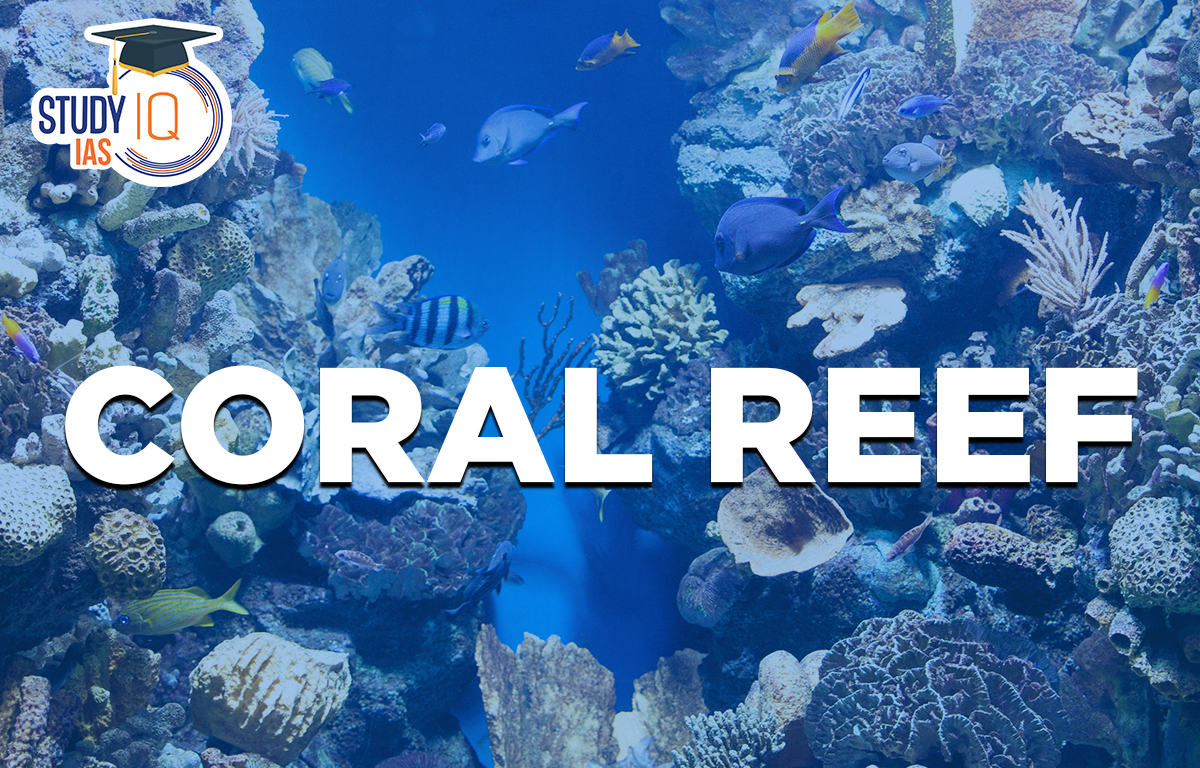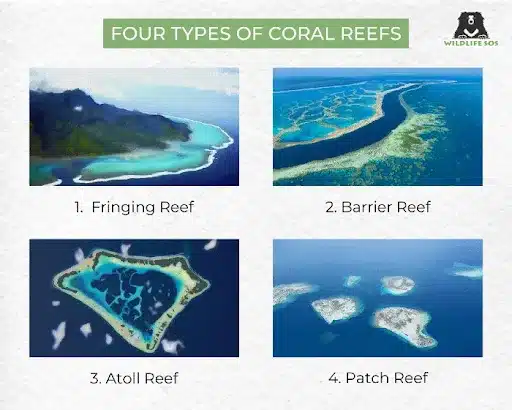Table of Contents
Context: A 24-year-long study reveals that coral cover in Lakshadweep has declined by nearly 50% since 1998, due to repeated marine heatwaves linked to climate change.
What are Coral Reefs?
- Coral reefs are vibrant underwater ecosystems formed by reef-building corals, which are marine invertebrates.
- Corals have a symbiotic relationship with algae (zooxanthellae), aiding in photosynthesis and reef growth.
- Corals secrete calcium carbonate, forming the hard exoskeletons that build reefs over time.
- Though they cover less than 0.1% of the ocean floor, they support 25% of all marine life.
- Often called the “rainforests of the sea” for their biodiversity.
Types of Coral Reefs
| Types | Details |
| Fringing Reefs | Close to shorelines, with shallow lagoons. |
| Barrier Reefs | Offshore, separated by deeper lagoons (e.g., the Great Barrier Reef). |
| Atolls | Ring-shaped reefs surround a lagoon, usually around submerged volcanoes. |
| Patch Reefs | Small, isolated reefs are found within lagoons. |
Fringing Reef
Fringing reefs are coral reefs that grow right from the shore and are close to land. They create a shallow lagoon between the beach and the main part of the reef. These reefs are usually narrow, about 1-2 kilometres wide, and slope steeply into deeper water. Coral polyps do not extend outward because of the quick drop in depth. Fringing reefs are the most common type of coral reef and can be found in many areas where coral reefs grow, such as the New Hebrides islands near Australia and the southern coast of Florida.
Barrier Reef
Barrier reefs are the largest type of coral reef, stretching for hundreds of kilometres and several kilometres wide. They form a broken ring around the coast or an island running almost parallel to it. While they are less common than fringing reefs or atolls, you can find them in the tropical Atlantic and Pacific. The Great Barrier Reef, located off the northeast coast of Australia, is the world’s largest example of this type, measuring 1200 miles long.
Atolls
An atoll is a circular reef system that surrounds a large, deep lagoon. The lagoon is usually 80-150 meters deep and can connect to the ocean through channels in the reef. Atolls are located far away from deep sea areas, where underwater features like sunken islands or volcanic cones help them develop.
There are three main types of atolls:
- True atoll – a circular reef with no island in the lagoon.
- Atoll with an island – a reef that surrounds a lagoon containing an island.
- Atoll island – an island formed by the erosion and deposition of waves on an atoll reef.
Atolls are more common in the Pacific Ocean, with well-known examples like the Fiji atoll and Funafuti atoll in the Ellice Islands. The Lakshadweep Islands also have many atolls. In the South Pacific, atolls are often found in mid-ocean, such as in French Polynesia and the Marshall Islands. The Indian Ocean also features atolls, including those in the Maldives and Seychelles.
Patch Reef
Patch reefs usually form between fringing and barrier reefs on the island platform or continental shelf. They are found in the shallow lagoons of larger reef groups or atolls. Patch reefs are typically close to shore and can be found in waters that are 10 to 20 feet deep. Some examples are found in Bermuda, the Bahamas, the Caribbean, and the Pacific Islands..
How are Coral Reefs made?
Corals are special creatures that are a mix of plants and animals. The animal part comes from a group called Anthozoa, while the plant part is from tiny algae called zooxanthellae, which have chlorophyll. These algae can make food through photosynthesis and provide energy for the coral polyps. In return, the polyps protect the algae.
Corals are made of tiny sea animals called polyps. They take calcium salts from seawater to build strong skeletons. Coral reefs form when baby corals attach to hard surfaces near the shore. When the polyps die, their skeletons create new homes for more polyps, and this process keeps repeating.
Over time, the buildup of these skeletons creates shallow rocks called reefs, which can eventually turn into islands. Corals have a tubular shape and can grow in different forms and colours depending on the salts they contain.
Conditions Required for Coral Reef Formation
- Temperature: The Ideal range is 23°C to 29°C.
- Depth: Found typically at depths < 50 meters for adequate sunlight.
- Salinity: Thrives in stable saline conditions.
- Water Clarity: Clear water is essential for photosynthesis.
- Substrate: Requires hard surfaces like volcanic rocks for coral larvae attachment
Coral Reefs in India
The length of India’s coastline is more than 7500 kilometres. There are hardly any Coral Reefs in India because of the subtropical climate. The Palk Bay, the Gulf of Mannar, the Gulf of Kutch, the Andaman and Nicobar Islands, and the Lakshadweep Islands are some of India’s most significant coral reef systems. The Lakshadweep reef is an example of an atoll among all of these coral reefs, while the others are all bordering reefs.
- Found in the Gulf of Kutch, the Gulf of Mannar, Palk Bay, the Andaman & Nicobar Islands, and Lakshadweep.
- Types: Fringing, Barrier, and Patch reefs.
- Notable examples:
- Gulf of Mannar: Over 3,600 marine species; declared a Biosphere Reserve.
- Lakshadweep: Known for atolls and coral banks.
- Andaman & Nicobar: Home to all three reef types.
- Palk Bay: Adapted to high sedimentation.
- Gulf of Kutch: Tolerant to high salinity and tidal changes.
Palk Bay Coral Reefs
Palk Bay, which is located on India’s southeast coast and is centred at 9°17’N and 79°15′, is divided from the Gulf of Mannar by the Mandapam Peninsula and the Rameshwaram Island. The only fringing reef in Palk Bay is 25–30 km long and less than 200 m broad it is located in the Pamban channel’s east–west direction. The highest depth of this reef is about 3 metres.
The Gulf of Mannar Coral Reefs
The 140 km-long Gulf of Mannar is located between Tuticorin and Rameswaram and is surrounded by a group of 21 islands. These 21 islands are a portion of the 140 km long and 25 km broad Mannar Barrier Reef, which is located between latitudes 8°47′ N and 9°15′ N and longitudes 78°12′ E and 79°14’E.
Andaman and Nicobar Islands Coral Reefs
The Andaman and Nicobar Islands are located between 91°-94° E longitude and 6°-14° N latitude. They are a group of 350 islands in the southern section of the Bay of Bengal, just 38 of which are inhabited. From the Burmese Irrawaddy Delta to the Arakan Yoma Range, these islands are located to the south. Nearly all of the Andaman and Nicobar group’s islands border reefs.
The Gulf of Kutch Coral Reefs
The Gulf of Kutch occupies the northernmost portion of the Saurashtra Peninsula and spans an area of around 7350 square kilometres. It is situated between latitudes 22°15′ and 23°40′ north and 68°20′ and 70°40′ east. These bordering reefs are about 170 kilometres long and 75 kilometres wide at the mouth, where they narrow at a longitude of 72° 20′. Numerous coral reefs have mud deposits on them, which have severely deteriorated the state of such coral reefs.
Lakshadweep Islands Coral Reefs
The Lakshadweep Islands are located in the Arabian Sea, about 225 to 450 kilometres from the coast of Kerala. They are found between latitudes 8°N and 12°3’N and longitudes 71°E and 74°E. This group has 36 small islands, 12 atolls, 3 reefs, and 5 submerged banks. The total area of the islands and lagoons is over 4200 square kilometres. The water around these islands is warm and humid, with temperatures between 28 and 31 °C and salinity levels of 34% to 37%.
India has a coastline of about 7517 kilometres, but only 6100 kilometres of that is on land. There are three main types of coral reefs in India: fringing, barrier, and atoll reefs. You can find coral reefs in places like the Gulf of Kutch, Gulf of Mannar, Palk Bay, Andaman & Nicobar Islands, and the Lakshadweep Islands. Some of the northernmost reefs are in the Gulf of Kutch in the northwest. Other coral areas can be found in Ratnagiri, Malvan, and Redi near Bombay, as well as at Gaveshani Bank near Mangalore.
At Quilon, near the coasts of Kerala and Tamil Nadu, corals can be seen along the shore. There are also many corals along the east coast, especially between Parangipettai (south of Cuddalore) and Pondicherry. The Andaman and Nicobar Islands, along with the Lakshadweep Islands, have many healthy coral reefs.
Important Coral Reefs in the World
Most reefs are located in the Pacific Ocean, Indian Ocean, Caribbean Sea, Red Sea, and Persian Gulf, all between the Tropics of Cancer and Capricorn. You can also find corals farther away from the equator in places like Florida and southern Japan, where warm ocean currents extend beyond the tropics. Overall, coral reefs cover about 110000 square kilometres (or 284,300 square kilometres) around the world.
- Tropical and subtropical regions, mainly between the Tropics of Cancer and Capricorn.
- Major regions:
- Coral Triangle (Southeast Asia)
- Great Barrier Reef (Australia)
- Indian Ocean Reefs (Maldives, Seychelles)
- Pacific Reefs (Fiji, Marshall Islands)
- Caribbean Reefs (Belize, Bahamas)
- Red Sea Reefs (Egypt, Sudan)
- Atlantic Reefs (Bermuda, Brazil)
Coral Reefs Ecosystem
Shallow Water
Coral reefs must develop in areas of shallow water. The distance between the reef’s surface and the water’s surface should not exceed 80 metres. The photosynthetic activities carried out by the Zooxanthellae require sufficient sunshine.
Hard or Semi-hard Surfaces
The coral polyp skeletons must be compacted, cemented, and solidified on a semi-hard or hard surface.
Clean Water
In locations with seas that are heavily contaminated with sediment, the lovely coral polyps die. Additionally, they vanish from seas that are murky. This is because the presence of sediments and murky water restricts the amount of sunlight that can reach the algae that support their existence.
Lukewarm Water
The warm ocean waters are intimately related to coral reefs. The water must be close to 20 degrees in temperature. So, coral reefs typically predominate on a continent’s eastern shore. This is not the situation with India, either, as the eastern seas are heavily contaminated with sediment.
Waters Splashed with Salt
The growth of coral polyps is greatly aided by the low saltiness of ocean waters. To preserve their skeletons, the polyps draw calcium from the water. Therefore, for coral reefs to thrive, there must be a low salinity environment.
Rich Nutritional Supply
Because of the consistent flow of nutrient-rich water supported by ocean waves, coral reefs thrive in seawater. Coral polyps multiply more quickly when given nourishment.
Coral Reef Importance
Corals are essential to the marine ecosystem’s health. They are referred to as the ocean’s rainforests since they are home to a variety of habitats. Many different kinds of fish can dwell in coral. The marine ecosystem’s main source of food is corals.
Economic
- Food for 500M people
- $36B tourism industry
- 64K jobs from the Great Barrier Reef
Environmental
- Home to 25% marine life
- Blocks 97% wave energy
- Maintains biodiversity
Cultural
- Spiritual value
- Preserves shipwrecks
Coastal Defense
The coastal regions are shielded by coral reefs from powerful ocean currents and waves. They offer defence against cyclones and ocean storms. These natural barriers have gained extra importance as storms in India are becoming more frequent as a result of climate change.
Food supply
Fish that are found in and around coral reefs provide millions of people, mostly those who live along coastlines, with a wholesome supply of protein. Some fishing companies rely only on coral reefs and the fauna they draw.
Medicinal attributes
As the sea’s pharmacy, coral reefs are believed to be. The corals draw certain fish, and some of those fish leave behind chemical residues that resemble those seen in hospitals. Source of anti-cancer & HIV drugs (e.g., AZT).
Meteorology
According to a recent study by the Indian Institute of Meteorology, corals along the northwestern coast provide information on the patterns of the arrival and departure of the Indian monsoon.
Tourism
Due to these stunning corals, the tourism industry accounts for the majority of the gross domestic product (GNP) of nations with coral reef industries. According to research, coral reefs are worth $10 billion, and they provide about $360 million in direct economic benefits annually.
Coral Reef Bleaching
90% of the nutrients produced by the algae are delivered to the coral hosts through a symbiotic interaction between the coral and zooxanthellae. However, this association is negatively impacted by extreme environmental stress, which results in the disappearance of symbiotic algae (zooxanthellae). As a result, coral bleaching occurs when the coral’s translucent tissue allows visibility of the white calcium-carbonate exoskeleton. In the absence of algae, corals become fragile and start to deteriorate after a few weeks of high sea temperatures.
Threats to Coral Reefs
From Climate Change
- Coral Bleaching due to ocean warming (e.g., 2016 El Niño).
- Sea Level Rise increases sedimentation, blocking sunlight.
- Intense storms cause physical reef damage.
From Pollution
- Plastics and marine debris injure corals.
- Ocean acidification weakens coral skeletons.
- Nutrient runoff causes algal blooms, suffocating reefs.
From Overfishing
- Depletion of key species disrupts reef food webs.
- Destructive techniques (e.g., blast and cyanide fishing) physically damage coral structures.
From Coastal Development
- Habitat destruction from construction.
- Sedimentation from land use changes reduces water clarity.
From Human Activities
- Unregulated tourism (anchor damage, trampling).
- Marine mining alters ecosystems.
Global Warming
The coral ecosystem is in trouble because the oceans are getting more acidic due to global warming. Also, as glaciers melt, sea levels are rising. This means that coral reefs get less sunlight and can be drowned by the water, making it hard for them to grow.
Coral Bleaching
When the water gets warmer, corals can bleach. They can’t handle high temperatures well, so they get stressed and push out the tiny algae that live with them. Without these algae, which are important for their survival, the corals can die.
Marine Debris
Corals are dying because of ocean pollution from plastic waste and other activities. Coral reefs need both air and space to survive. If sea pollution keeps getting worse, we could lose these important reefs sooner than we think.
Stronger Storms and Acidification of the Ocean
Stronger storms are causing big ocean waves that can break and damage coral reefs. These waves can even destroy coral colonies and make these areas unsafe for marine life. Also, as more CO2 gets absorbed by the water, the pH levels rise. Higher pH levels can weaken coral skeletons, making them more likely to get sick and suffer damage from storms.
Ozone Depletion
Coral polyps have a natural way to protect themselves from harmful UV rays. However, with the increasing amount of radiation from the sun, corals in shallow waters can be harmed or even destroyed. This is a problem because the extra UV rays can harm the coral, making it harder for them to survive.
Get Details here on Threats to Coral Reefs
Great Barrier Coral Reef
With more than 2900 different reefs and 900 islands, this is the largest and most amazing coral reef environment on Earth. It is located in the Coral Sea off the north-east coast of Australia, near Queensland. This reef is the biggest structure made by living things and can even be seen from space. It was built by billions of tiny creatures called coral polyps.
Coral Reef Animals
Many creatures rely on reefs to live, including fish, corals, lobsters, clams, seahorses, sponges, and sea turtles. Coral reefs are like living museums that also hold thousands of years of history.
Coral Reef Conservation – Indian Initiatives
- Wild Life Protection Act, 1972: Hard corals are protected under Schedule I.
- Environment Protection Act, 1986: Empowers marine conservation.
- Coastal Regulation Zone (CRZ) 1991 & 2011: Prohibits coral mining and regulates coastal activity.
- Island Protection Zone (IPZ): Safeguards island ecosystems.
- Marine Protected Areas (MPAs): Zones to conserve reef biodiversity.
- National Coral Reef Research Centre: Promotes research and awareness.



 List of National Parks in India 2025, Ch...
List of National Parks in India 2025, Ch...
 Bonnet Macaques: Habitat, Features, Beha...
Bonnet Macaques: Habitat, Features, Beha...
 Periyar Tiger Reserve, Map, Flora, Fauna...
Periyar Tiger Reserve, Map, Flora, Fauna...

























